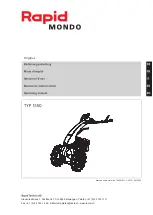
1-2
Introduction
UNIT 1
Precautions
Safety.
Extreme caution must be exercised when operating the BOLT. It produces an intense beam of
invisible light that can cause permanent damage to the eye with prolonged exposure.
Operational.
In order to insure accurate and reliable readings, it is vitally important to clean the ports on the
tester, as well as the ferrules on the patch cords, before each use. If dirt, dust, or oil are allowed to build up
inside the connector, the surface of the laser diode may become scratched, producing erroneous results.
Replace the dust caps on the tester ports and patch cords when not in use.
NEVER LOOK INTO A LIGHT SOURCE OR THE END OF A FIBER THAT MAY BE ENERGIZED BY A
SOURCE!
Required Accessories
Cleaning Supplies.
Fiber ferrules, connector ports and bulkheads should be cleaned with 99% or better
isopropyl alcohol and a lint-free cloth. A can of compressed air should be available to dry off the ferrules, and
to blow dust from the connector ports and bulkheads.
Patch Cords.
Two identical patch cords are required to connect the BOLT to the system under test, and an
additional patch cord is required to loop back the two fibers being used for the test. The connector styles on
the patch cords must match the type on the BOLT and the type of the bulkheads in the system under test.
Applications
Fiber Length Measurement.
The BOLT uses a “round robin” method of length measurement. This method
requires two fibers from the same fiber cable to be looped back at one end with a patch cord. Light is injected
into one of the fibers by the transmitter and is received by the detector connected to the other fiber. The round
trip travel time is converted into length in kilometers and divided by two to arrive at the length of the fiber cable.
It is not necessary to test each fiber for length; the length measurement applies to all fibers in the cable.
Fiber Identification.
The BOLT provides a pulsed mode for easy fiber identification. Fibers are identified by
clamping a fiber identifier onto a jacketed fiber, which produces a tone to indicate presence of a signal. This is
useful for locating fibers that are marked incorrectly or not marked at all.
Stabilized Single-mode Light Source.
In Continuous Wave Mode, a steady beam of 1310 nm infrared laser
light is injected into the fiber. This light is stabilized at -10 dBm, and when used with a power meter, functions
as a single-mode light source for fiber attenuation testing.


























